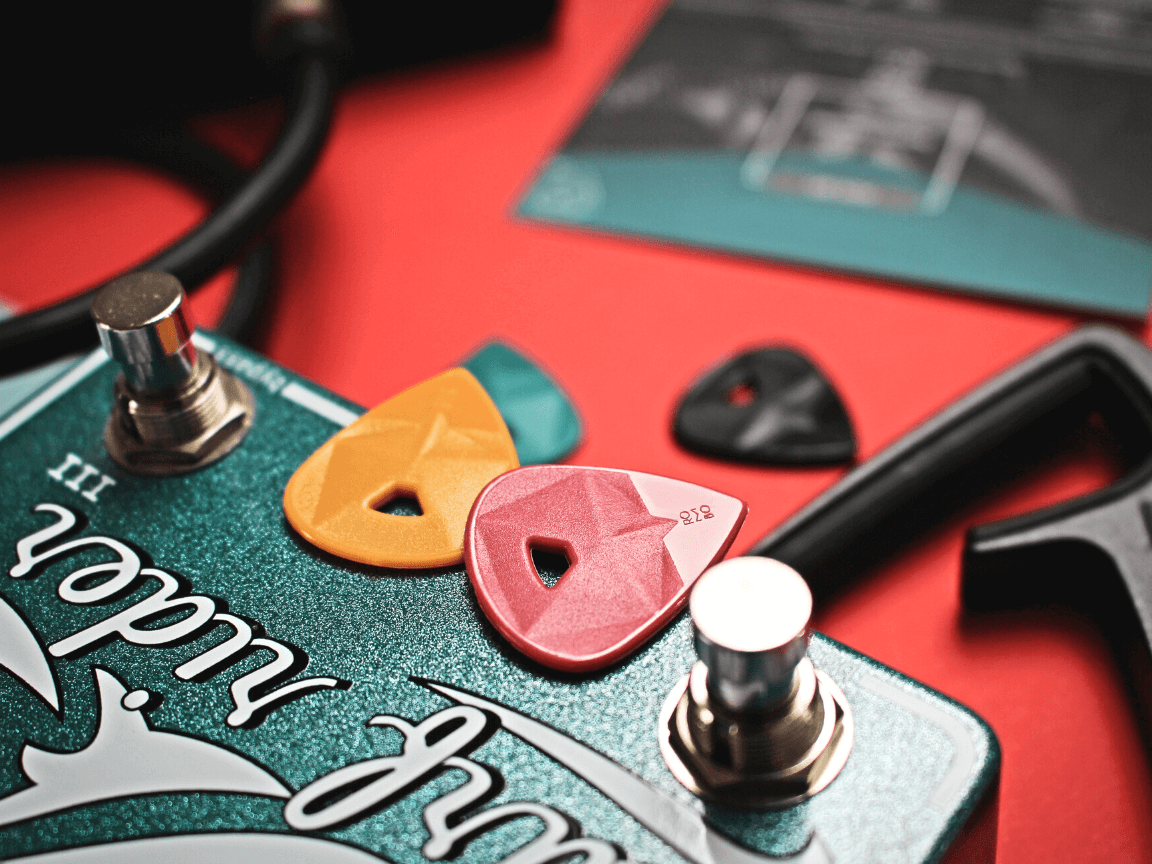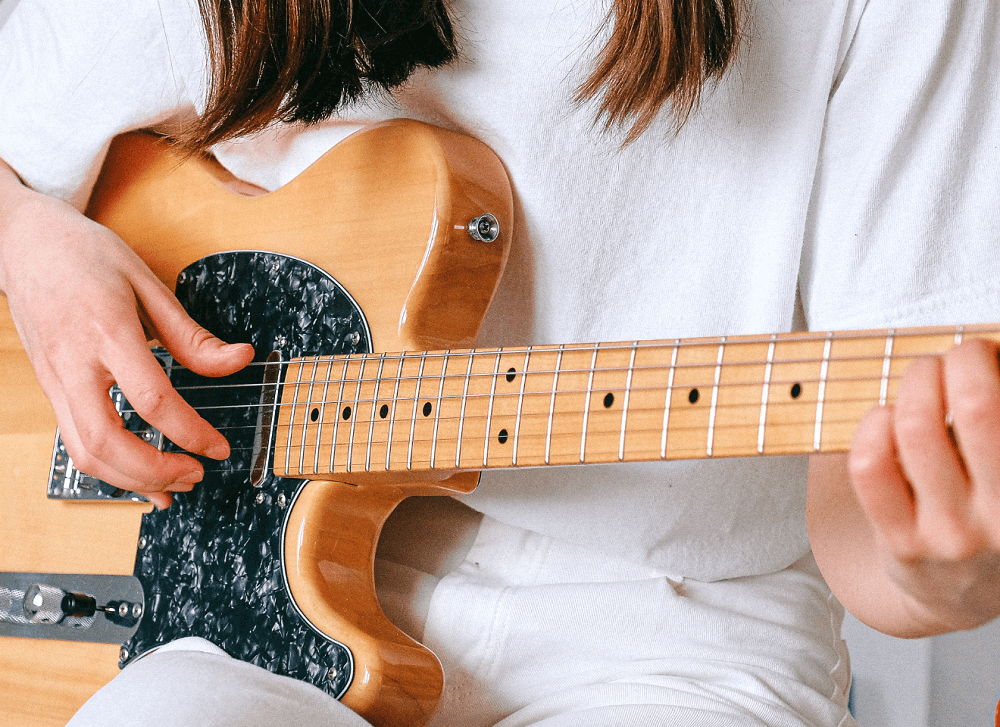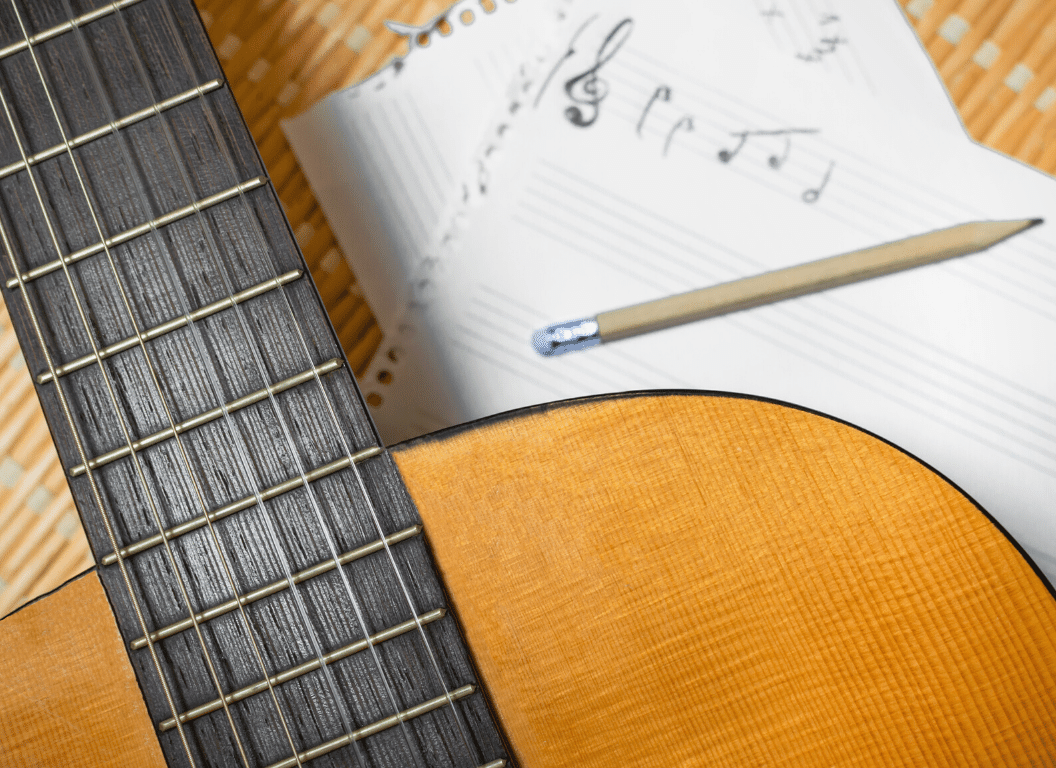If you’re a guitarist, you know that there are a lot of decisions to make when it comes to equipment, from strings to amps to pedals.
But one of the most important pieces of gear is often overlooked: the guitar pick.
A guitar pick is an essential part of a guitarist’s toolkit, and the type of pick you choose will affect your playing.
Different styles of picks offer different levels of control and create very different sounds when used on guitar strings.
Picks range in size from thin to thick, with thicker picks providing a softer sound and thinner picks offering more grip and bite
In this post, we’ll take a look at all the different types of picks, the advantages of using each one of them, and how to choose one for yourself.
Table of Contents
- Are guitar picks necessary?
- Types of Guitar Picks
- Advantages of Using a Guitar Pick
- Disadvantages of Using a Guitar Pick
- Alternatives to Using a Guitar Pick
- Is picking harder than strumming?
- Should I learn to play fingerstyle or use a pick?
- Is it better to play guitar with or without a pick?
- Do all professional guitarists use picks?
- Final thoughts
Are guitar picks necessary?
No, guitar picks are not necessary. Many guitarists prefer to play without a pick, using their fingers instead. Additionally, some guitarists use alternate tools such as coins, credit cards, or even drumsticks to pluck the strings. Ultimately, the choice of whether to use a pick or not is up to the individual guitarist.
Although, guitar picks are generally used when playing electric guitar and can open up a lot of sonic possibilities.
The right pick can help you to achieve the exact sound and feel that you’re looking for.
It all depends on the style of music that you’re playing, so it’s important to consider your own sound and how the pick could complement or enhance it.
For example, if you’re playing metal music, a heavier pick may help you to achieve the desired sound.
On the other hand, if you’re playing jazz or folk music, a lighter pick might be better suited for those styles.
If you plan on playing flamenco, then a pick might not be necessary at all.
Types of Guitar Picks
Let’s take a closer look at some of the different types of guitar picks that are available.
This will come in very handy if you want to find the right pick for your style of playing.
1. Different Materials
Guitar picks come in all shapes, sizes, and materials, so it’s important to know what type of pick is best for your playing style.
The most common materials used for guitar picks are celluloid, nylon, and metal.
Celluloid picks are the most popular, as they provide a smooth, glossy feel and produce a bright, articulate sound.
Nylon picks, on the other hand, tend to be softer than celluloid, and they produce a warm, mellow tone that’s great for playing slower, bluesy music.
Lastly, metal picks are usually made of stainless steel or bronze and offer an aggressive sound that’s perfect for metal and rock genres.
Even though metal picks don’t produce as clear of a tone as nylon or celluloid, they do provide maximum durability.
You could also find other materials such as wood, glass, stone, and even bone picks, although they’re usually less popular than the first three options.
2. Different Shapes
In terms of shape, guitar picks come in either teardrop, triangle, and jazz shapes, each of which produces a different sound and can be used for different genres of music.
The teardrop shape offers a smooth sound and is great for strumming chords.
Hence, it’s a great pick for playing folk, pop, and even country music.
On the other hand, triangle picks are much sturdier and produce a clear, crisp sound that’s perfect for playing metal, rock, or any other genre that requires precision.
Finally, jazz picks are the most rounded shape and have a softer attack than other picks.
Although they have a brighter sound than teardrop or triangle picks, they don’t provide as much clarity.
I found that, ultimately, the choice of shape is a matter of personal preference, you can even play with a penny if it gets to the point that you don’t have a pick available.
3. Different Grips
In terms of grip, guitar picks come in either pointed or beveled edges, allowing you to choose one that fits your playing style best.
Pointed edges offer a firmer grip and are great for faster playing styles, while beveled edges provide a softer attack and make it easier to make quick transitions between strings.
Ultimately, the grip of a guitar pick is something that you need to experiment with in order to find what works best for you.
You’ll find that some players prefer pointed edges while others like the beveled ones better.
Personally, I like to use a combination of both as it allows me to switch between them depending on the song or style I’m playing.
4. Different Sizes
As for size, guitar picks come in three basic sizes: small, medium, and large.
Even though that sounds very simple, it’s still important to get the right size in order to make sure that you’ll be able to accurately pick notes and chords.
- Small picks are great for playing lead guitar, as they allow for precise note picking and fast playing.
- Medium picks are ideal for rhythm guitar, allowing you to strum with more power without having your hand slip off the pick.
- Finally, large picks are best suited for bass guitar and provide a thick sound that’s great for playing funk and reggae.
Again, the size of a pick is something that you have to experiment with in order to find what works best for you.
For example, some players even use very thin picks for lead guitar and thicker ones for rhythm.
So it’s not something that’s set in stone or a rule that you have to adhere to, but it’s certainly something that can be useful for finding the right sound.
5. Different Textures
Guitar picks also come in varying textures, from smooth to rough, and even with patterns or knurling.
In general, smooth picks are better suited for playing lead guitar, as they offer a softer attack and make it easier to accurately pick notes.
Rough picks, on the other hand, provide more grip and are great for rhythm playing.
In other words, when you’re playing chords, you want to make sure that the pick won’t slip out of your hand, which tends to happen very often with smooth picks.
Patterned or knurled picks are also available and are great for anyone looking to add some extra grip to their picking experience.
What these picks do is increase the surface area of the pick, which in turn makes it easier to grip and hold on to.
5. Custom Picks
For players looking for a truly unique sound, custom guitar picks is an excellent option.
These picks can be made from any material and come in a variety of shapes, sizes, and textures to suit any individual player’s needs.
Custom guitar picks often produce a more pronounced tone and provide a great way for players to stand out from the crowd.
Whether you prefer a bright, articulate tone or a warm, mellow sound, you should go ahead and get it done for yourself.
Advantages of Using a Guitar Pick
Even though there is an ongoing debate that a pick is not necessary for playing guitar, there are still many advantages to using a pick.
The most obvious advantage of a guitar pick is the increased accuracy and control that it allows.
A pick makes it easier to precisely attack each note, giving you more control over your sound.
With a pick, you won’t have to worry about your fingers slipping or getting tired from strumming.
It also allows for greater speed and agility, which is great for playing lead lines and solos.
Let’s take a quick look at some of these advantages and why it’s important to use a pick:
1. Increased speed and accuracy
The first and most obvious advantage of using a guitar pick is increased speed and accuracy.
A pick allows you to quickly and accurately attack each note without having to worry about your fingers slipping or getting tired from strumming.
This is great for lead lines and solos, as it allows you to play faster and more precisely.
Also, for those of you who are looking to play chords with more clarity and accuracy, a pick is the way to go.
2. Better control over the sound
The second advantage is the increased control over your sound.
A pick allows you to attack each note in a more precise manner and also helps to reduce unwanted noise from string buzz or dead notes.
It also provides greater control over volume, allowing you to easily make adjustments depending on the style of music you’re playing.
On the other hand, a pick gives you the ability to apply pressure, which helps to shape your sound and add texture.
This pressure is something that you can’t replicate with your fingers alone, and although it won’t make or break your sound, it can certainly add a unique flavor to your playing.
3. More power for strumming and lead guitar playing
A pick will also give you more power for strumming and lead guitar playing.
It gives you the ability to dig into the strings and produce a fuller sound, which is great for heavy songs or styles of music that require more aggression.
Additionally, it helps to bring out each note in a more pronounced way, allowing your lead lines and solos to stand out more clearly.
On top of that, it helps you to create a smoother transition between notes, which is essential for complex lead parts.
4. Makes it easier to play difficult chords
For some people, it could also make it easier to play difficult chords.
Although you can certainly strum with your fingers, it’s much easier to grip the strings and control each note using a pick.
I would say that if you’re having difficulty playing certain chords or transitions, then a pick could be the answer or at the very least, help to make it easier.
As I’ve mentioned before, having to think less about your picking hand, and focusing more on your fretting hand will help you be an overall better guitar player.
Even if the difference is not too noticeable in the beginning, every detail adds up and will help you become a more competent guitar player in the long run.
5. Helps create a unique, recognizable sound
Lastly, using a pick can help you create a unique, recognizable sound.
In my experience, when I play with a pick I can produce different tonal qualities compared to when I play without one.
This could be due to the way the pick is scraping or bouncing off the strings or simply the way I play when I use one.
Either way, it’s a great way to add some personality to your playing and make yourself stand out from the crowd.
Disadvantages of Using a Guitar Pick
Now that we’ve looked at the advantages, there are some drawbacks to consider as well.
The main thing to keep in mind is that a pick can’t always replicate the same sound as you would get from using your fingers.
For certain styles of music, such as fingerpicking or strumming, it doesn’t produce the same warm, organic sound you would get with your fingers.
Also, depending on how hard you grip the pick and how often you play, it’s possible to develop blisters or calluses on your hand.
Let’s take a closer look by examining some of the specific disadvantages.
1. Not suitable for certain styles of music
The first disadvantage is that it’s not always suitable for certain styles of music.
Although you can certainly play fingerpicking and strumming with a pick, it won’t quite produce the same sound as playing with your fingers alone.
That’s because it can’t replicate the warm, organic sound you would get with your fingers.
Plus being able to pick two strings at once is something you can’t do with a pick, so it could limit your playing in some ways.
2. Can lead to blisters and calluses on your hand
Although this is debatable, some people believe that using a pick can lead to blisters and calluses on your hand.
This is because you’re constantly gripping the pick tightly and scraping it against the strings, which could cause friction and eventually lead to calluses or blisters.
Also, if you use a pick with sharper edges or made of harder materials, this could make the issue worse.
The counterpoint to this is that the same could be true when playing with your fingers, so it really depends on how often you play and the struggle you’re willing to endure 🙂
3. Might limit your creativity
Lastly, using a pick might limit your creativity in some ways.
Over the years, I’ve seen friends become so comfortable with the pick that they’re not willing to try other styles or techniques.
This could be due to a lack of confidence in their picking hand, but it can also limit what you’re able to play.
For example, if you’re used to playing with a pick, transitioning back to playing without one could be a challenge and take some getting used to.
Also, you don’t want to be that guy who only plays with a pick and misses out on the amazing sounds you can get without one.
Alternatives to Using a Guitar Pick
Of course, there are alternatives to using a pick – you can use your fingers or thumb!
But which one is better and why?
Let’s take a closer look:
1. Using your fingers
The main advantage of using your fingers over a pick is that you get the warm, organic sound associated with fingerstyle playing.
This can be great for certain genres such as folk, country, or blues where warmth and texture are desired.
Plus it gives you more control over the strings, allowing you to pick two strings at once or do intricate fingerpicking patterns.
The downside is that you won’t be able to play as fast as you can with a pick, and it could take some time to build up your finger strength.
2. Slapstyle or thumb picking
The other alternative is slapstyle (or thumb picking).
This involves using your thumb to pluck the strings and gives you a percussive sound that can be great for certain genres such as funk or rock.
It’s also really easy to learn and requires minimal effort, so it makes sense why some players prefer it.
The downside is that it doesn’t give you the same warm sound as fingerpicking, so it may not be suitable for certain genres.
For bassists, this can be a great way to add some texture and spice up their playing, since slapstyle is naturally part of their playing.
But for guitarists, it might take some time to get used to since the sound is usually quite different.
3. Hybrid picking
The last alternative is hybrid picking, which involves using a pick along with your fingers.
I found that this is a great way to produce interesting textures and can be used in many different genres.
It gives you the best of both worlds – the clarity of a pick along with the warmth and texture of your fingers.
The downside is that it takes some time to get used to and requires good coordination between your two hands.
But if you’re able to pull it off, it can be a great way to add some interesting sounds to your playing.
Is picking harder than strumming?
Picking and strumming are two very different techniques used in guitar playing and each comes with its own challenges.
When it comes to deciding which is harder, it really depends on the individual.
Picking is a technique that involves using your pick to pluck individual strings, and it requires a lot of precision and accuracy.
On the other hand, strumming involves using a pick or your fingers to rapidly move across the strings in a single motion.
Strumming can be more difficult for some because it requires the player to be able to keep a consistent rhythm and to be able to switch between different chords quickly.
Ultimately, it’s up to the individual to decide which technique is more difficult for them.
Should I learn to play fingerstyle or use a pick?
It really depends on what type of music you want to play and the sound you are looking for.
If you are looking for a more traditional sound, like folk or country, then fingerstyle is probably the way to go.
Fingerstyle allows you to play multiple notes at once and gives you a lot of control over the sound.
It also allows you to play more intricate melodies and create unique rhythms.
On the other hand, if you are looking for a more modern sound, like rock or metal, then using a pick is probably the way to go.
A pick allows you to play faster and with more power, and it is easier to create a consistent sound across multiple strings.
Ultimately, the decision is up to you and what type of music you want to play.
Is it better to play guitar with or without a pick?
It really depends on the type of sound you’re trying to achieve.
Generally, playing guitar with a pick gives you a brighter, crisper sound, while playing without a pick gives you a warmer, rounder sound.
If you’re playing a style of music that requires a lot of strumming, like folk or country, then a pick is probably the way to go.
On the other hand, if you’re playing a style of music that requires a lot of fingerpicking, then playing without a pick might be the better option.
Ultimately, it comes down to personal preference and the type of sound you’re looking for.
Experimenting with both methods can help you find the sound that’s right for you.
Do all professional guitarists use picks?
No, not all professional guitarists use picks.
While some may prefer to use a pick, others may opt for the more traditional finger-picking technique.
Finger-picking involves using the fingers of the right hand to pluck the strings, and can produce a softer, more delicate sound.

This technique is often used in genres such as folk, blues, and classical, and is favored by many professional guitarists.
Some players may use a combination of both picking and finger-picking, depending on the style of music they are playing.
Ultimately, it comes down to personal preference and the type of sound the guitarist is trying to achieve.
Final thoughts
After exploring the pros and cons of using guitar picks, it’s clear that whether or not a guitar pick is necessary depends on the individual.
For some, the pick provides a better grip and control, making it easier to play fast and intricate pieces.
For others, the pick may be a hindrance, taking away from the natural feel of the strings.
Ultimately, it’s up to the individual to decide whether or not to use a pick.
If you’re just starting out, experimenting with both styles may be the best way to determine which one works best for you.
Whatever you decide, keep practicing and have fun!

More than 10 years of experience playing and writing about guitars! When not writing, I can be found strumming away some Johnny Cash tunes. Favorite all time guitar is the Gibson Les Paul. #TeamGibson




